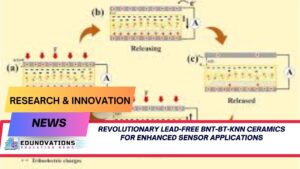Discover the innovative dual-ion nano sensor for water quality monitoring that simplifies pollutant detection and ensures safe drinking water.
Water contamination continues to pose a significant global challenge, impacting public health and environmental sustainability. To address this, researchers at the Sri Sathya Sai Institute of Higher Learning (SSSIHL) have pioneered a groundbreaking dual-ion nano sensor for water quality monitoring. This advanced technology offers a cost-effective, rapid, and highly accurate solution for detecting multiple water pollutants simultaneously.
Understanding the Need for Efficient Water Testing
Access to safe drinking water remains a pressing concern worldwide. Traditional testing methods are often time-consuming, require sophisticated laboratory setups, and may not detect multiple contaminants simultaneously. Mercury and nitrite are among the most hazardous pollutants that frequently contaminate drinking water, posing severe health risks such as neurological damage, kidney failure, and methemoglobinemia in infants. The introduction of affordable water quality testing with nano sensors provides a viable solution to these pressing issues.
How the Dual-Ion Nano Sensor Works
The innovative sensor utilizes nanotechnology to enable real-time detection of mercury and nitrite in water. The sensor operates by leveraging highly selective chemical receptors that bind specifically to these contaminants, producing an immediate and measurable electronic response. This method ensures that the detection is both rapid and highly sensitive, even at trace levels of pollutants. Researchers emphasize that this system is capable of detecting contaminants simultaneously, which greatly reduces testing time and costs.
Key Features of the Nano Sensor
- Real-Time Analysis: Offers immediate detection without the need for lengthy laboratory processes.
- Dual-Ion Detection: Capable of simultaneously identifying mercury and nitrite.
- Eco-Friendly Design: Utilizes minimal chemicals, aligning with green technology principles.
- Portable and User-Friendly: Can be deployed in remote locations, ideal for rural communities.
- Cost-Effective: Reduces expenses associated with traditional multi-step water analysis.
The sensor’s portability and ease of use make it an essential tool for field-based water monitoring, particularly in regions where laboratory facilities are scarce.
Advantages for Rural Communities and Public Health
The adoption of eco-friendly nano sensors for water pollution detection has significant implications for public health, especially in rural and semi-urban areas. Local health agencies and environmental monitoring bodies can deploy these devices to:
- Identify and mitigate contaminated water sources promptly.
- Reduce outbreaks of waterborne diseases.
- Monitor water quality in schools, hospitals, and public spaces.
- Support governmental initiatives aimed at achieving sustainable development goals related to clean water and sanitation.
Moreover, the sensor’s affordability and real-time capabilities make it suitable for community-driven monitoring programs, empowering residents to actively safeguard their own water resources.
Expert Insights on Nano Sensor Technology
Dr. Suresh Kumar, an environmental scientist specializing in water purification technologies, commented:
“The development of a portable nano sensor for simultaneous water contaminant detection represents a transformative step in water quality management. Such technology democratizes access to accurate water testing, particularly in resource-limited settings.”
Experts also highlight that the nano sensor could potentially be integrated into smart water management systems, offering automated, continuous monitoring for households and industries alike.
Implications for Environmental Sustainability
The environmental benefits of using nano sensors extend beyond public health. By enabling targeted detection of pollutants:
- Industries can ensure compliance with environmental regulations.
- Policymakers can develop evidence-based interventions.
- Researchers gain access to real-time data for longitudinal studies on water quality.
By reducing the need for extensive chemical usage and laboratory testing, these sensors also minimize environmental footprints, aligning with broader goals of sustainable technology implementation.
Integrating Technology with Education
Educational institutions and research centers can harness this technology to enhance learning and innovation. For instance:
- Students can conduct hands-on experiments on water testing without extensive lab setups.
- Research projects can focus on improving nano sensor efficiency and adapting them for detecting additional contaminants.
- Institutions can use field data to analyze environmental trends and develop community awareness programs.
For those preparing for exams and research, integrating this technology with NCERT courses, notes, and video lectures can provide practical applications of scientific principles.
- Explore NCERT Courses: NCERT Courses
- Access Current Affairs: Current Affairs
- Download Free NCERT PDFs: Free PDFs
- Watch Educational Videos: Videos
Future Prospects
The research team at SSSIHL continues to innovate, aiming to enhance the sensor’s capabilities to detect a broader range of contaminants such as lead, arsenic, and pesticides. These advancements will make water quality monitoring even more comprehensive and versatile.
Additionally, partnerships with schools, local NGOs, and environmental agencies will be key to deploying these sensors in real-world scenarios. The collaboration can help ensure that safe drinking water becomes accessible to vulnerable populations nationwide.
Conclusion
The advent of the dual-ion nano sensor for water quality monitoring marks a pivotal moment in environmental technology. Combining affordability, portability, and real-time accuracy, this innovation is poised to redefine how communities monitor and ensure water safety. With the integration of educational insights and community engagement, these nano sensors offer a sustainable and practical solution for both urban and rural populations.
Toppers Use Mind Maps to score more than 95%
NCERT Class 11th Commerce Mind Maps
Add to cartOriginal price was: ₹999.00.₹199.00Current price is: ₹199.00.NCERT Class 12th Chemistry Mind Maps
Add to cartOriginal price was: ₹199.00.₹75.00Current price is: ₹75.00.NCERT Class 12th Commerce Mind Maps
Add to cartOriginal price was: ₹999.00.₹199.00Current price is: ₹199.00.NCERT Class 12th Science Mind Maps
Add to cartOriginal price was: ₹999.00.₹199.00Current price is: ₹199.00.NCERT Mind Maps For Class 10th
Add to cartOriginal price was: ₹999.00.₹199.00Current price is: ₹199.00.
Purchase Today
FAQs
- What is a dual-ion nano sensor for water quality monitoring?
It is a portable device that simultaneously detects multiple water pollutants such as mercury and nitrite. - How does the dual-ion nano sensor detect mercury and nitrite?
The sensor uses selective chemical receptors that bind to pollutants, producing an immediate electronic signal. - Why are affordable water quality testing with nano sensors important?
They reduce costs, save time, and make water safety testing accessible to rural communities. - Can this nano sensor provide real-time detection of mercury and nitrite in water?
Yes, it offers instant analysis without needing laboratory equipment. - Is the nano sensor eco-friendly?
Yes, it minimizes chemical usage and supports green technology initiatives. - How portable is the nano sensor for water contamination detection?
It is lightweight, compact, and ideal for field monitoring in remote areas. - Can schools and educational institutions benefit from this sensor?
Yes, it provides hands-on learning for students and supports research projects. - What are the health risks of mercury and nitrite in drinking water?
Mercury can cause neurological damage, while nitrite affects oxygen transport in the blood. - Where can I learn more about practical applications of nano sensors in water testing?
Resources include NCERT courses, videos, and notes for environmental science studies. - What are the future enhancements planned for the nano sensor?
Researchers aim to expand its detection range to other contaminants like arsenic and pesticides.














